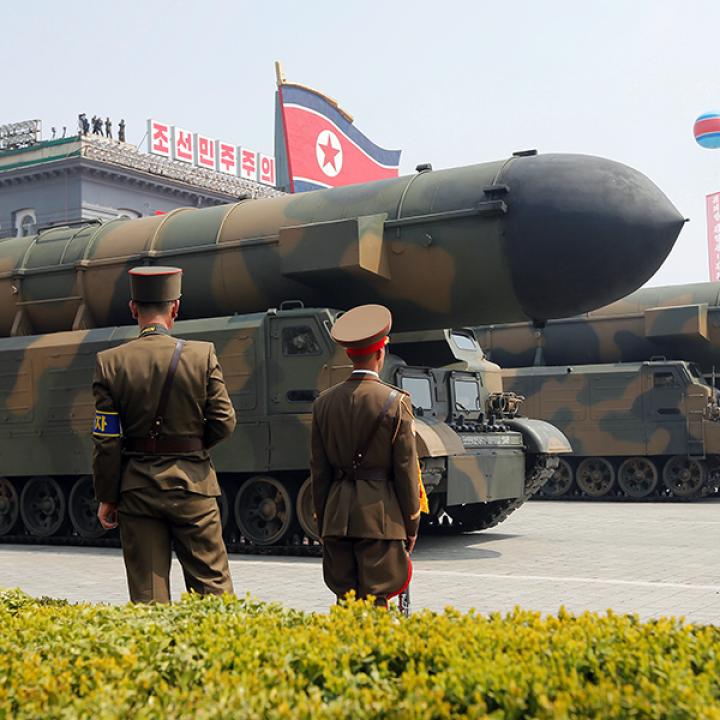
- Policy Analysis
- Policy Alert
Iran's New Ballistic Missile May Have North Korean ICBM Links

The recent reveal indicates strong technical cooperation with Pyongyang, raising concerns that Iran might be on the path to developing a nuclear-capable ICBM down the road.
On September 22, following a year of speculation, Iran displayed its newest ballistic missile as part of its annual "Sacred Defense Week" military parade. The unveiling was accompanied by older video footage showing the missile being test fired.
Called "Khoramshahr" -- after the southwestern Iranian city that has long been a symbol of national resistance against foreign invasion -- the new single-stage, 13-meter-long missile has an announced range of 2,000 km and an 1,800 kg warhead, which separates at the last phase flight and can be either unitary or multiple. According to Gen. Amir Ali Hajizadeh, commander of the Islamic Revolutionary Guard Corps Aerospace Force, the system is in the final stages of development.
The missile is markedly wider than Iran's previous models, probably in order to house a new propulsion system and more liquid fuel in a shorter fuselage. The finless configuration suggests a new control and guidance system; more significantly, it gives Iran the option to transport the missile in hot deserts and cold mountainous areas inside a handling canister, offering increased operational flexibility and a better-controlled handling environment.
The Khoramshahr might therefore be placed atop a more road-mobile multi-axle transporter erector launcher (TEL) akin to North Korea's Chinese-origin vehicles. The Iranians have yet to publicly announce a new customized TEL, but they are known to have recently developed several indigenous high-performance chassis that can be modified to transport heavy ballistic missiles on rural roads. The most notable design, the 10x10 Zoljanah, was unveiled in May 2014 and can reportedly carry a thirty-ton payload, similar to the estimated launch weight of the Khoramshahr's closest North Korean analogue, the Hwasong-10.
Drive train would be the main limitation on developing all-terrain TELs, but this potential problem may have been sorted out on September 12, when the state-owned automaker Iran Khodro signed a deal with German firm Daimler AG to distribute high-performance Mercedes trucks in the Islamic Republic. According to Khodro's website, a second deal to be signed next month will create a joint venture to produce heavy vehicles in Iran, including Actros trucks. The company's engine manufacturing division, Iran Khodro Diesel, is also in negotiations with the German technology giant to produce large diesel engines in Iran. Currently, Tehran lacks the know-how to design such high-performance engines on its own, but modern and efficient German designs would be ideal for use in indigenous missile TELs, tank transporters, and patrol/missile boats. During last week's military parade, all missile systems were carried by foreign-sourced trucks whose make and model markings were carefully covered.
SIGNS OF NORTH KOREAN HELP?
As indicated above, the Khoramshahr looks similar to the North Korean Hwasong-10/Musudan/BM-25 missile minus its warhead. Since 2005, reports have been circling of Pyongyang delivering several Hwasong-10s to Iran. According to a WikiLeaks document from 2010, U.S. intelligence sources suspected Tehran had imported the missile in order to get its hands on a high-performance propulsion system, even though the Hwasong-10 was still untested at the time.
When North Korea unveiled the missile in 2010, it was believed to be around 12 meters long and 1.5 meters wide. Once it was test launched in 2016, it was estimated to have a 1,000-1,250 kg payload and a maximum range between 2,500 and 4,000 km, making it an intermediate-range ballistic missile.
On July 11, 2016, Iran conducted its first secret test launch of the Khoramshahr, which apparently failed shortly after liftoff. The missile was tested again on January 29, 2017, reportedly flying around 1,000 km. If the Khoramshahr is indeed a variant of the Hwasong-10, that would be a worrisome sign given reports that the North Korean missile uses the same engine as its current ICBMs.
It is not known whether the missile tested in the Iranian footage shown at last week's unveiling actually carried any payload, but if the announced 1,800 kg warhead capacity is true, it would theoretically enable Tehran to develop a fairly large nuclear payload for the system. UN Security Council Resolution 2231 discourages Iran from developing nuclear-capable missiles, but the Khoramshahr seems to fit that description, in addition to being another clear step toward a reliable ICBM capability.
Farzin Nadimi is a Washington-based analyst specializing in the security and defense affairs of Iran and the Persian Gulf region.



